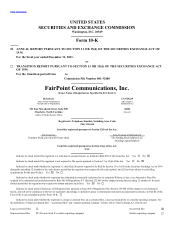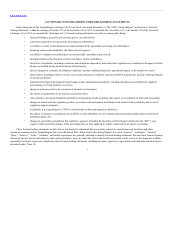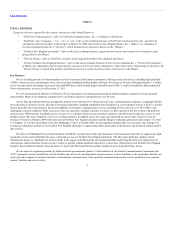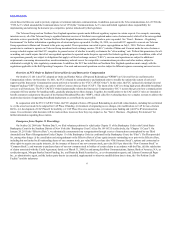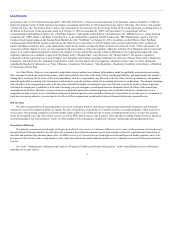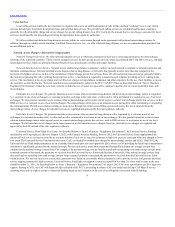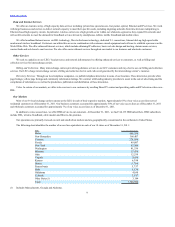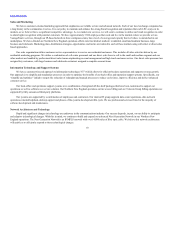FairPoint Communications 2011 Annual Report Download - page 9
Download and view the complete annual report
Please find page 9 of the 2011 FairPoint Communications annual report below. You can navigate through the pages in the report by either clicking on the pages listed below, or by using the keyword search tool below to find specific information within the annual report.
Table of Contents
Voice Services
Local calling service enables the local customer to originate and receive an unlimited number of calls within a defined “exchange” area. Local calling
services include basic local lines, local private lines and switched data services. We provide local calling services to residential and business customers,
generally for a fixed monthly charge and service charges for special calling features. In a LEC’s territory, the amount that we can charge a customer for local
service is determined by rate proceedings involving the appropriate state regulatory authorities.
We offer switched and dedicated long-distance services within our service areas through resale agreements with national interexchange carriers. In
addition, through our wholly-owned subsidiary FairPoint Carrier Services, Inc., we offer wholesale long-distance services to communications providers that
are not affiliated with us.
Network Access Charges / Intercarrier Compensation
We offer network transport services to wholesale customers for their use in connecting end users to the interexchange
networks of the wholesale customer. These network transport services include special access services, which are primarily DS-1 and DS-3 services, and high
speed digital services, which are primarily Ethernet-based services provisioned over fiber and copper facilities.
Network access enables long-distance companies to utilize our local network to originate or terminate intrastate and
interstate communications. Network switched access charges relate to long-distance, or toll calls, that typically involve more than one company in the
provision of telephone service as well as to the termination of interexchange private line services. Since toll calls and private line services are generally billed to
the customer originating the call or ordering the private line service, a mechanism is required to compensate each company providing services relating to the
service. This mechanism is the access charge and we bill access charges to long-distance companies and other customers for the use of our facilities to access
the customer, as described below. Network switched access compensation is subject to the FCC CAF/ICC Order, as described below in “Item 1. Business –
Regulatory Environment”. Under the new rules, network switched access revenues are expected to continue to decline, but on a more predictable basis with
fewer disputes.
We generate intrastate access revenue when an intrastate long-distance call involving an interexchange carrier is originated
by a customer in one of our exchanges to a customer in another exchange in the same state, or when such a call is terminated to a customer in one of our local
exchanges. We also generate intrastate access revenue when an interexchange carrier orders special access to connect interexchange private line services, such as
HSD services, to a customer in one of our local exchanges. The interexchange carrier pays us an intrastate access payment for either terminating or originating
the communication. We bill access charges relating to such service through our carrier access billing system and receive the access payment from the
interexchange carrier. Access charges for intrastate services are regulated and approved by the state regulatory authority.
We generate interstate access revenue when an interstate long-distance call is originated by a customer in one of our
exchanges to a customer in another state, or when such a call is terminated to a customer in one of our exchanges. We also generate interstate access revenue
when an interexchange carrier orders special access to connect interexchange private line services, such as HSD services, to a customer in one of our local
exchanges. We bill interstate access charges in the same manner as we bill intrastate access charges; however, interstate access charges are regulated and
approved by the FCC instead of the state regulatory authority.
As described below in “Item 1. Business – Regulatory Environment”, the Universal Service Funding
mechanisms are being replaced, effective January 1, 2012, with Connect America Funding. Prior to 2012, the Universal Service Fund supplemented the
amount of local service revenue received by us to ensure that basic local service rates for customers in high-cost areas are consistent with rates charged in lower
cost areas. The Universal Service Fund and its successor, CAF, are funded by monthly fees charged to interexchange carriers and LECs. Until 2012, the
Universal Service Fund made payments to us on a monthly basis based upon our cost support for LECs whose cost of providing the local loop connections to
customers is significantly greater than the national average. For our rural service areas, these payments fluctuated based upon our average cost per loop
compared to the national average cost per loop. For example, if the national average cost per loop increased and our operating costs (and average cost per loop)
remained constant or decreased, the payments we received from the Universal Service Fund would decline. Conversely, if the national average cost per loop
decreased and our operating costs (and average cost per loop) remained constant or increased, the payments we received from the Universal Service Fund
would increase. For our non-rural service areas, these payments were based on cost models which estimate the cost to provide services and generate universal
service support payments for high-cost areas. Universal Service Fund high-cost support revenue accounted for less than 2% of our total revenue in the year
ended December 31, 2011. As described below in “Item 1. Business – Regulatory Environment”, we expect 2012 CAF to be equivalent to our 2011 high-cost
support. Starting in 2013, our CAF will depend on the resolution of the FCC’s proceeding to adopt a CAF cost model and develop CAF Phase II for our
operating areas and our right to accept or refuse that funding based on our evaluation of the cost of our obligations associated with the funding.
8

